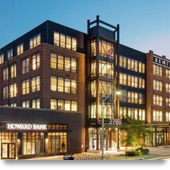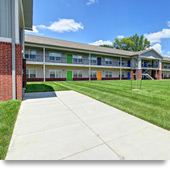Rethinking American Communities

To achieve its mission, HUD must connect Americans in need with resources that will allow them to live safe and financially secure lives. Unfortunately, many families have limited affordable options without government assistance and have difficulty connecting to meaningful opportunities to increase their economic standing. We need a new approach to ensure families are connected to services in their communities that put them on a path to self-sufficiency.
HUD User's case studies and regulatory solutions are resources that communities can use to promote healthy, safe, affordable housing and improve connections to services that enhance economic opportunities for families.

Pittsburg State University Joins in the Block22 Development to Revitalize Downtown Pittsburg, Kansas
Pittsburg State University (PSU), with 7,000 students, is located only one mile south of downtown Pittsburg, the education, healthcare, retail, and hospitality center of southeastern Kansas.
Read More>>
Spartanburg County Foundation Helps Grow Partnerships to Revitalize a Neighborhood
The Northside of Spartanburg, South Carolina, consists of over 400 acres around the former Spartan Mills, once a center of local employment.
Read More>>
Johns Hopkins University Forms Partnerships to Strengthen Nearby Neighborhoods in Central Baltimore
Johns Hopkins University has long recognized that blighted and unsafe conditions in the neighborhoods surrounding its Homewood campus in Baltimore could deter potential students and staff from affiliating with the university.
Read More>>
Louisville, Kentucky: Family Scholar House Helps Residents Achieve Economic Independence through Academic Success
Family Scholar House (FSH) seeks to help two vulnerable populations in Louisville, Kentucky: single-parent families and young adults who have recently aged out of foster care.
Read More>>

Beyond Counting Units: Maximizing the Social Outcomes of lnclusionary Housing
This report provides a framework for promoting greater social inclusion and economic advancement as a third goal for inclusionary housing programs.
Read More>>
Rent and Ride: Affordability Is About Both
This report reviews household income relative to the combined cost of housing and transportation to compare location affordability in New York with that in the other 19 largest U.S. cities.
Read More>>
Creating Moves to Opportunity: Experimental Evidence on Barriers to Neighborhood Choice
This report explores whether low-income households stay in low-opportunity neighborhoods because of preference or because of barriers to their moving to high-opportunity areas (census tracts with rates of upward income mobility).
Read More>>
Supply Skepticism: Housing Supply and Affordability
This report discusses the effects of an increased supply of market-rate housing on housing affordability.
Read More>>




